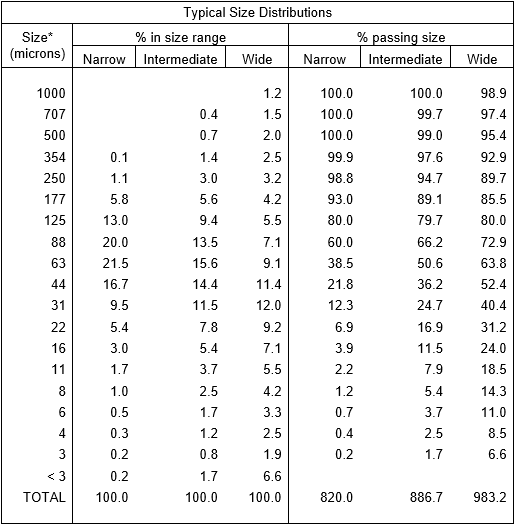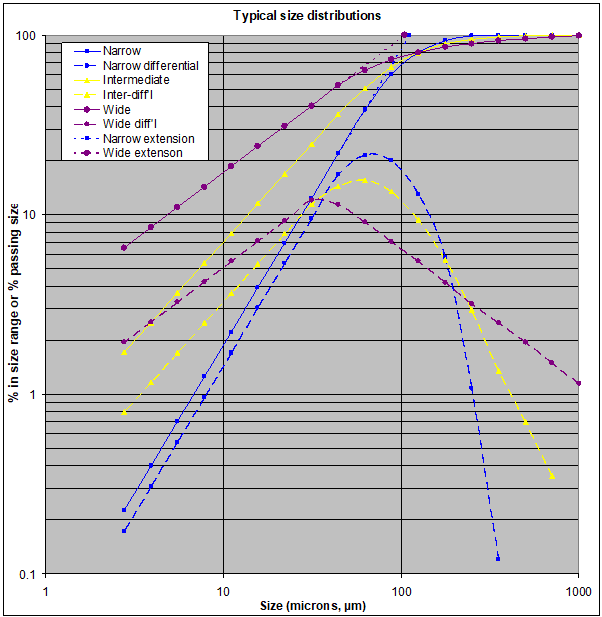Table of Contents
- Size is crucial to virtually all mineral processing
- A size range in a standard series is generally identified by the bottom size in the range
- A single size parameter is not enough to define a size distribution
- Narrow size ranges are generally best for following separation processes
- Sizes are usually arranged in a ratio series
– Ratios of 2, √2, 4√2 are the norm - This gives systematic coverage of a wide range of particles sizes and is convenient in many ways.
- Also relates better to the effect of size on the behaviour of the particles in many separations.
Size Distribution
- Size distributions are generally tabulated if they are to be used in further calculations
- May be plotted in many ways – useful visualisation
- Cumulative log-log has many advantages
– Disadvantage is compression of coarse sizes
– Compensate by expanding Y-scale - Differential plots rely on consistency in size intervals
Size Distribution Functions
- Many functions for describing size distribution mathematically
– none universal
– none with valid theoretical basis - Gaudin-Schumann the most useful to fit the fine sizes
Y = 100 x (d/D)n
Where ‘Y’ is the % passing size, d
‘D’ corresponds to the 100% passing size
– extrapolate back
‘n’ is a constant corresponding to the slope
Size Distribution Expressions
- Straight line part of the narrow distribution is expressed by:
Y = 100 x (d/111)1.65 - That for the wide distribution by:
Y = 100 x (d/104) 0.75 - Note the wider distribution has the smaller index.
- This relationship is a straight line on a log-log plot
- Over the same size range (where the relationship applies) the differential plot will also be a straight line plot
- It will be parallel to the cumulative plot
- A good differential plot depends on accurate ratios in the size intervals

Y = 100 x [d/D]n
or log(Y) = n x log[d/D] + 2
- Where y is the % passing size d, D corresponds to 100% passing and n is a constant corresponding to the slope of the log-log plot
The straight line portion of the narrow size distribution in the fine sizes is thus expressed by:
Y = 100 x [d/111]1.65
and of the wide distribution is expressed by:
Y = 100 x [d/104]0.75
- Note that the wider distribution has a smaller index than the narrow distribution.
- This is a straight line on a log-log plot and over the same range the differential plot will also be a straight line on log-log (see graph)
- Straight line in fine sizes on log-log plot very common from typical grinding circuit
- Parallel line for differential plot goes with this (straight forward maths)
- Narrow size distributions have a higher peak on a differential plot than wide size distributions reflecting the greater concentration of material at or close to the peak value
- On a cumulative plot the slope is greater for narrow size distributions

Note although 80% passing size is the same for all distributions the rest of the distributions are very different, e.g. compare wide and narrow distributions at 3µm – narrow 0.25% passing, wide 7% passing.
Measuring Size
- Many methods using:
– Screens
– Settling rate
– Light scattering
– Laser diffraction
– Capacitance (Coulter counter), etc. - Desirable to get sized material in hand
– Can analyse
– Do mineralogical study
– Specialised tests - Screens are best for +38µm
- Cyclosizer best for sub-screen sizing
Screening
- Cut out accurate sample from product
- Wet screen on fine screen (38 or 43µm)
- may need to add dispersant
- removes clay,
- and fines which tend to adhere to coarse particles
- settle
- dry if nothing finer to be done
- Dry oversize – not too hot (depends on mineral)
e.g. pyrrhotite very reactive - Screen on appropriate stack (Ro-Tap)
- Combine minus 38µm
- Decant minus 2-5µm, settle and dry
- Cyclosize
Cyclosizing
- Cyclone principle with repeated cycling of the underflow
- Variation in dimensions of overflow tube and entry size permits progressively finer cuts
- Does not adhere to strict √2 sequence
– 44, 33, 23, 15, 11 µm cutpoints (quartz)
– commercial reasons! - Uses a lot of water (can dissolve metal from very fine particles
– temperature control for consistent sizes - Sized fine particles available for assay
Enhanced Fine Sizing Procedure
- Advantage if we could recover all solids
- Remove finest solids by beaker decantation
– chose conditions for cutpoint of about 5 µm (quartz) - May now all collect solids from Cyclosizer effluent in suitable centrifuge to complete a size-mass balance on the sample
– account for all mass
– account for all metals - If finest solids left in cyclosizer feed the centrifuge collection would be inefficient
Sizing by Cyclosizer
For the full procedure refer to the paper on the CD by Stewart and Restarick – Improved Cyclosizing Technique, Proc AusIMM, No.251, September, 1974, pp 9-10.
- Size fractions available for analysis
- Cut sizes affected by:
– particle shape
– particle SG
– water viscosity
– water density - Best run at set temperature (constant sizing)
- Calibrate to give continuity with screens (graphical method on log-log best)
Basis of Size Correction
- Difference from nominal calibration mainly due to differences in SG of particles

– primary calibration is for quartz - Secondary differences due to particle shape
- Correction best done empirically on graph
- A further reason for temperature control is ρw
- Temperature control to maintain constant water density and viscosity
Other Particle Properties
- Bulk properties
– size
– shape
– SG
– resistance to fracture
– magnetic response
– mineral content
– metal content
– cracking - Surface properties
– surface area
– mineral exposure
– appearance, fluorescence
– electrostatic conductivity
– surface hydrophobicity (flotation) - Chemical solubility
– by component
Bold blue for most important properties for separations
Other Metallurgical Testing
- Liberation testing
– heavy liquids
– super-panner
– Jones tube
– QEM*SEM - Crushing
– Manufacturers tests
– SAG & AG drop test - Grinding
– Bond grindability
– Work index - Flotation
– Denver cell
– ‘Bottle reaching’
– locked cycle - Magnetic/electrostatic/gravity
– specialised equipment available
– generally consult supplier e.g. Gekko, Kelsey - Leaching (CIL)
– big range of tests
– consider separately
